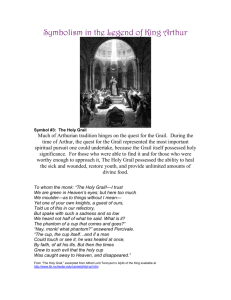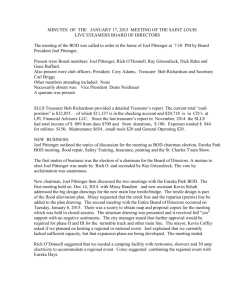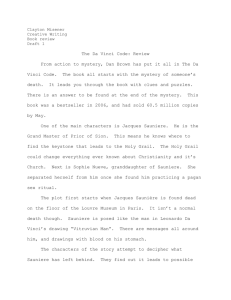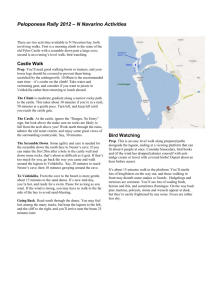Montségur and the Sabarthez
advertisement
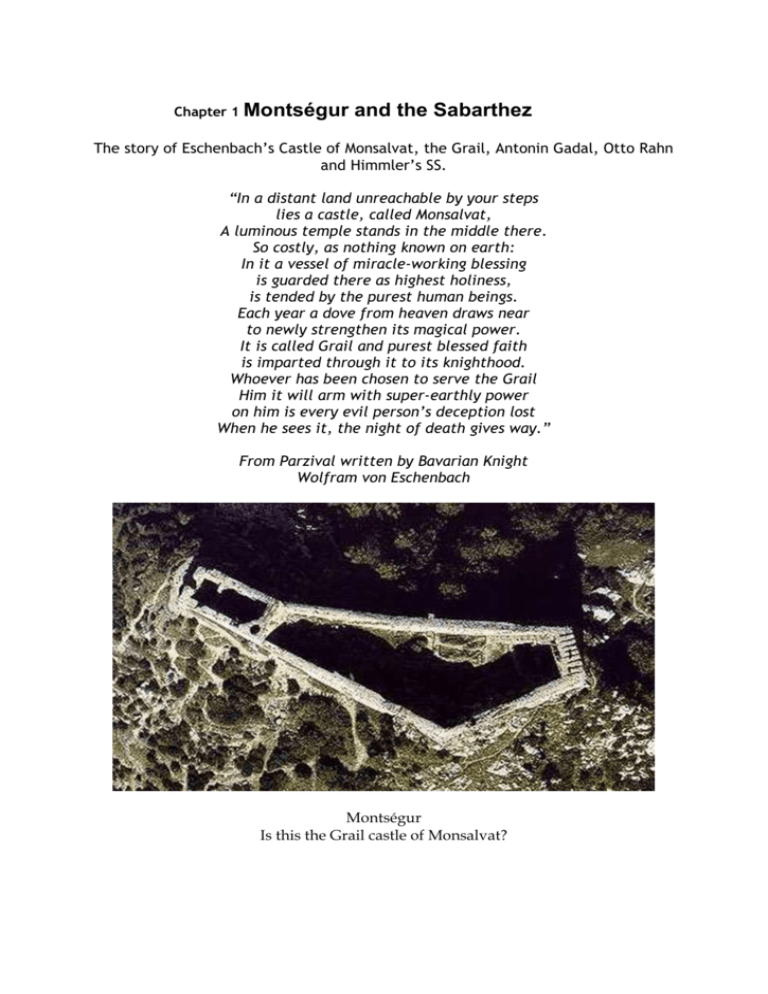
Chapter 1 Montségur and the Sabarthez The story of Eschenbach’s Castle of Monsalvat, the Grail, Antonin Gadal, Otto Rahn and Himmler’s SS. “In a distant land unreachable by your steps lies a castle, called Monsalvat, A luminous temple stands in the middle there. So costly, as nothing known on earth: In it a vessel of miracle-working blessing is guarded there as highest holiness, is tended by the purest human beings. Each year a dove from heaven draws near to newly strengthen its magical power. It is called Grail and purest blessed faith is imparted through it to its knighthood. Whoever has been chosen to serve the Grail Him it will arm with super-earthly power on him is every evil person’s deception lost When he sees it, the night of death gives way.” From Parzival written by Bavarian Knight Wolfram von Eschenbach Montségur Is this the Grail castle of Monsalvat? No story of the Midi-Pyrénées can be complete without including the awesome and tragic castle of Montségur and the story of the Cathars. Montségur is situated in the Ariège département of France and in the 13th century it was besieged by 10000 Royal Catholic troops towards the latter days of the Albigensian Crusade. In the mid 13th century 220 of these Perfecti were burned at the foot of Montségur. It is a level of piety that the modern cynical world will find hard to comprehend. Documents from the Inquisition confirm that the night preceding the capitulation of Montségur, four Cathars let themselves down on ropes down the steep sides of the mountain. Their names were Aican, Poitevin, Hugh and Raymond d’Alfaro bailiff of Avignonet and they made good their escape to nearby mountains. Tradition has it that a fire was lit on the neighbouring mountain of Biaorta announcing to the Cathari besieged in the castle Montségur that the treasure was safe and that they could now lay in peace. Part of this treasure is thought to have been the ‘Grail Stone’ and a sacred book of the Cathars and there is a strong belief that these were hidden in one of the caves of the innumerable grottos of the Sabarthez. Curiously the story of the Cathars features usually only in passing in stories of Rennes le Chateau, as a kind of backdrop to the main story and yet it is very possibly the most vital key to the whole enigma. Saunière’s church was right in the heart of Cathar country and there are several signs around the cemetery which seem to give hints of Cathar belief. The view to the west from the Tour Magdala overlooks Cathars country. Most of the useful information about the Cathars comes from the German researcher Otto Rahn, a man once described as the real Indiana Jones, and he studied the Cathars under tutelage of his mentor Antonin Gadal, a French mystic and Cathar historian in the 1930s. Rahn had lived in the area of Ussat-les-Bains in what is now the Hotel-Restaurant des Marroniers and had leased the place for nine years. During his stay, which in the end only lasted a year, he developed a deep platonic friendship with Arthur Caussou, an old Ariegois shepherd who told Rahn the legend of Esclarmonde de Foix (literally `light of crystal' of Foix). This is Repanse de Schoye, the bearer of the Grail in Wolfram von Eschenbach’s Parzival. According to this legend, on the evening of the fall of Montségur the young woman was given custody of the Grail that had been guarded by these Cathar ‘Parfaits’. “Montségur was in danger for the armies of Lucifer had besieged it. They wanted the Grail, to restore it to their Prince’s diadem from which it had fallen during the fall of angels”. Caussou went on “Then at the most critical moment, there came a white dove from heaven which with its beak split Tabor [Montségur] in two”. Esclarmonde was the keeper of the Grail (Repanse de Schoye) and she allegedly threw the “sacred jewel” into the depths of the mountain. She then climbed to the top of Montségur [Mount Tabor] then Esclarmonde transformed herself into a white dove and flew off towards the ‘Mountains of Asia’, where, according to Caussou, she still resides in the East in the “earthly paradise”. It is perhaps important to note here that these particular legends, and in accord with Wolfram von Eschenbach’s account, regard the Grail as a stone not a cup. According to records an Esclarmonde de Pereille daughter of Raymond de Pereille and Corba de Pereille received Consolamentum on March 13 th and were subsequently burnt along with some two hundred others on March 16 th 1244. If one is looking for a solution to enigmatic signs found in this story, ignoring these legends will result in failure to find anything. Whether it suits ones comfortable belief or not legends surrounding the Graal abound and seem particularly strong in this Ariège region to the west of Rennes le Chateau towards Montségur. The original Mount Tabor, in the plain of Esdrelon in Galilee is the place where transfiguration of Jesus is thought to have taken place. It is thought that the mountain immediately across the road from Rahn’s dwelling at Ussat-les-Bains, which is called ‘Holy Mountain’, is the site of a Cathar First initiation ceremony and indeed a cave that contains a crude altar can be seen directly from Rahn’s window. But let us look at this enigmatic character Otto Rahn and his associations who first led us into the world of the Cathars and see if we can discover what fascinated them so much. Rahn was born in Michelstadt, Germany on the 18 February 1904 and obtained a bachelor degree in Philology and History in 1924. In 1930 Rahn began to travel and visited Paris, Provence, Switzerland, Catalonia and Italy. However in 1931, after a meeting with an Austrian Army Colonel called Karl-Maria Wiligut-Weisthor, he visited the French Pyrenees and Spion, the German nickname for Montségur and for this first time trip he was accompanied by Otto Abetz who headed the Nazi Dienstelle Ribbentrop engaging in espionage to influence French politics. His other companion was thought to be Heinrich Himmler, who of course was later to become leader of the German SS. So keen was Rahn on the history of the Cathars that he had made himself fluent in both French and Occitan, a language that is still spoken in the Languedoc area as a first language by an estimated two million people and had earned himself a meagre living teaching German and French and this sustained him in his travels. In 1932 a controversy broke in the French magazine La Depeche du Midi, the same magazine that had first broken the news of Rennes le Chateau in 1956, and the article featured a group called the Polaires, a society linked to the H.P. Blavatsky’s Theosophical Society, indeed they had the same address in Paris. The Polaires were excavating the caves of Ussat and Ornolac and the magazine article had also mentioned Rahn in passing and the article stated that there had still been some anti–German feeling left over from WWI. Although based in Paris the Polaires did seem to have some leanings towards the emerging Nazi party in Germany and were right wing and were also anti-Semitic. They like the Nazis believed in the existence of Ultima Thule, the supposed place in the Arctic or Antarctic region where a race of super beings supposedly had once lived. Antonin Gadal, probably the greatest Cathar historian of them all, had come to Rahn’s defence and Rahn himself had written an article saying that he had never heard of the Polaires. Some of the Polaires had been Nazi collaborators during WWII and in one instance a Polaires Journalist called Jeanne Canudo had informed on the Martinist Constant Chevillon who was subsequently executed by the Gestapo. Chevillon had been a close friend of Camille Savoire who you’ll remember was Plantard’s family doctor and who had introduced him to George Monti when a teenager. George Monti, whom Pierre Plantard claimed to be an acquaintance you will remember, was poisoned in 1936. In their 1931 excursion Rahn and his two infamous companions had also explored the grottos of the Sabarthez area and indeed he and his group had visited the famous Ornolac and the massive cavern of Lombrives, here was the huge chamber known as ‘The Cathedral’. Here we have a stalagmite called ‘The Tomb of Hercules’ and other called ‘The Altar’, these names are also used by the Grail writer Wolfram von Eschenbach. These caves contain Templar symbols as well as Cathar and there is a famous carving of a bleeding lance and this particularly excited Himmler. Rahn had published his findings in two books: The first published in Heidelberg (most commentators make a point of saying that the date was on the Summer Solstice) was Kreuzzug gegen den Graal (Crusade against the Grail) the second published in 1937 was called Luzifers Hofgesind (Lucifer’s Court). These two books however are largely thought to have been entirely plagiarised from the work of Antonin Gadal who never published any work of his own. Neither of these books were best sellers his first book only sold 5000 in Germany and roughly the same in France. Rahn (or Gadal) saw that the heroes in Wolfram von Eschenbach’s Parzival were real middle age personalities and that Parzival himself was in fact the well known Le Vicomte (Viscount) de Carcassonne Trencavel who was one of the leading heroic victims of the Albigensian Crusade. To Rahn, Esclarmonde de Foix was Repanse de Joie. The mother of Trencavel, Adelaide de Toulouse made a perfect Herzeloide; the hermit Trevrizent was the Cathar Bishop Guilhabert de Castres; Anfortas was Raimon-Roger de Foix and Montségur was Monsalvat. The castle is protected by a Fountain “Salvage” and Rahn believed this to be the natural phenomenon called Fontestorbes a few miles to the east of Montségur, which is a cave that curiously fills with water then empties completely, cycling continuously in about 45 minutes. The forest of Monsalvat is called Briciljan and close to Montségur is Priscilien Wood. Rahn was under the total conviction that the Fortress on the Pog of Montségur was the Temple of the Grail. Rahn saw the Cathars as the Church of the Grail and were associated with Dante’s mystical group called Fideles d’Amour. Rahn relates that some Templar tunics were found alongside the Cathar black cassocks with a yellow cross inside some of the caves of the Sabarthez. Most significantly Rahn describes the Grail as a perfect Emerald with 144 facets or 144 tablets of stone engraved in emerald. This Emerald graced the crown of Lucifer and symbolised the Third Eye which fell to earth; precisely on the Pog of Montségur according to Rahn. One thing that strikes the reader of Rahn’s books is that they are clearly a labour of love. Fascinating that it may be the whole story of Rahn’s fascination with Montségur has some disturbing aspects. The preface of Luzifers Hofgesind is written by a man called Arnaud d’Apremont and is an ideological treatise that is vaguely racist and overtly anti-Semitic and to all intents and purposes reflects the beliefs of the National Socialists. It seems Rahn was caught in the wrong country at the wrong time for what Rahn was saying fitted into Nazi ideology perfectly and it does seem that Rahn himself spoke of a Grand United Europe. Rahn did not see Lucifer as Satan or the Devil but as the Pyrenean Abellio or the Celtic Belenos or the Nordic Baldur or the Greek Apollo, all God’s of luminosity. The Cathars called this God Lucibel ‘the Light Bearer’ or Polaire - The Polar and we are drawn back to Ursa Major and Minor again. Rahn was probably somewhat naïve in this and failed to see the aspects of corrupt power that comes with this. For Rahn ‘The Light’ came not from the east but from the north and he subsequently took his research to several of the ancient and sacred places of Europe. For example; The Forest of Teutoburg scene of Arminus’ victory over the Romans; to Externsteine, site of Irminsul, sacred symbol of the Saxons; to Thingveillir the assembly place of the Icelanders; to Reykholt the birthplace of Snorri Sturlusson who wrote the Edda. His book The Court of Lucifer is a journey through the ‘garden of roses’ Rahn’s affectionate term for Kingdom of the Asgardian Elf, Lorin a realm closed to non-believers or the uninitiated. Rahn dreamt of a return to Ultima Thule the supposed ancestral home of the European Hyperboreans. What he didn’t consider was the power that this gives to some and its effect on their psyche that fuels their simple justification for making war against their fellow human being in the name of their perceived God or their perverted vision of their place on earth. Rahn’s story is an example of how, despite clearly having a high intellect, one can get drawn into very dangerous areas and groups without realising it through having esoteric interests. In 1933 Rahn joined the German Writers Association and as such vowed to defend without reservation German literature in conformity with the spirit of National Socialism and it is believed that Rahn became one of Roehm’s brownshirts at this time. Rahn had a French girlfriend at this time called Bricon who had come to Germany specifically to learn about National Socialism. She wrote for the French newspaper La Republique under the name of Etienne. Rahn wrote to Gadal that he had spent the New Year of 1933 with her. On the recommendation of a letter to the SS recruitment office from Karl Wolff, the principle SS recruiting and personnel vetting officer, Rahn was admitted to the SS on 12th March 1936 at the specific personal instruction of Himmler and the following month was promoted to Untersharfuhrer and joined Himmler’s personal staff. Rahn joined the Black Order, the Allemeine-SS (as opposed to the Waffen-SS, the combat branch). Whilst again in Paris Rahn received a personal telegram from Himmler offering him 1000DM per month to write another book, however Rahn soon realised the nature of the regime he had joined when his immediate superior was arrested and when another college Ladame tried to intervene Rahn had been ordered to keep a watch on him. In his SS file a German researcher sites that Rahn had written a note on the 23rd February 1936 headed “My combat for the Third Reich before 1933” which states that before taking power I had written a book and articles that today represent an inheritance of National Socialist thought.” The source of Rahn’s original inspiration, Karl-Maria Wiligut-Weisthor later became a Brigadier General in the SS and also became Himmler’s Occult advisor and was known in the Nazi party inner circles as ‘Hitler’s Rasputin’. On February 28th 1939 Rahn wrote a letter of resignation to Gruppenführer Karl Wolf telling of “grave reasons” for his resignation which he would only tell to the Reichführer. On March 13th 1939 Otto Rahn disappeared. Two months later on 18th May 1939 a death notice appeared in the Berlin edition of the “Völkischer Beobachter” it said: “SS – Obersturmführer OTTO RAHN died tragically in a snow storm during March 1939. We mourn for this dead comrade, a decent SS-man and creator of outstanding historical, scholarly works.” One may draw ones own conclusions from the sudden death of Otto Rahn but in June 1943 a team of experts appeared at Montségur and at various other places in the Languedoc including Rennes le Chateau. These experts were historians, archaeologists and geologists. They trashed around for several months but without Rahn and Gadal they found nothing. Himmler decided on a different approach and he appointed another. This would be the end of the matter were it not for the story of SS Colonel called Otto Skorzeny the same man who had rescued Mussolini in a daring mountaintop raid. In February 1944 Skorzeny and a selected unit of SS commando set up camp at Montségur itself. Montségur is approachable on three sides, Skorzeny and his team decided to scale the sheer drop of several thousand feet. After abseiling down the vertical face they allegedly found a walled up cave. Skorzeny sent a message to Berlin: “Ureka” And signed it – “Scar” The reply was: “Well Done. Congratulations. Watch the sky tomorrow at Noon. Await our arrival” Reichführer It was March 16th 1944; it seems that Skorzeny had unwittingly found something on the 700th anniversary of the fall of Montségur and was surprised to come across a large gathering of Cathar descendants heading for the Castle to pay homage to their ancestors. It was significant because an ancient prophesy had foretold that at the “end of 700 years, the laurel will blossom again on the ashes of the martyrs”. The signal to watch the sky when Skorzeny and his team arrived at the castle at noon was significant because German aircraft arrived and formed a Celtic cross in the sky. The following day Reichsminister Alfred Rosenberg and Colonel Wolfram Sievers of the Ahnenerbe arrived at Montségur to congratulate Skorzeny. The treasure found apparently consisted of: Thousands of Gold Coins Items believed to have come from the Temple of Solomon, which included Gold plates and fragments of wood which had once made up the Ark of Moses….a gold plated table, a candelabra with seven branches, a golden urn, a staff, a harp, a sword, innumerable golden plates and vessels, many small belts of gold and a number of precious jewels and onyx stones, some of which bore inscriptions. Twelve stone tablets bearing pre-runic inscriptions which none of the experts were able to read. A silver cup with an emerald-like base made of what appeared to be Jasper. Three gold plaques on the cup were inscribed with cuneiform script in an ancient language. A large number of religious objects of various types…crosses from different periods which were of gold or silver and adorned with pearls and precious stones. Precious stones in abundance in all shapes and sizes. Many of the gold coins were melted down and turned into ingots. When the town of Merkers fell to the 3rd US Army under General George Patton his men discovered these ingots in nearby salt-mines in which this treasure was stored. The estimated value of the gold was $250,000,000 (by 1945 estimates). In 1906 the French author we’ve already mentioned Josephin Péladan wrote a best selling book called Le Secret des Troubadours de Parsifal à Don Quichotte and this inspired many treasure hunters. These treasure hunts centred on Ussat-les-Bains where Otto Rahn later set up his headquarters in 1931; indeed it was Péladan’s book that had first inspired Rahn to come to the Languedoc. It was in fact Péladan who had made the first link that Montségur was the Castle of Monsalvat, the holy mountain of Parzival and Lohengrin. However it was from a man named Antonin Gadal, who wrote ‘Heritage of the Cathars’, that Péladan and Rahn took most their information. Gadal was born in 1877 in the heart of what is known as the Sabarthez, an area of caves through which the Ariège River flows. The area around Ussat was known as Tarusks country and has been inhabited by a Celtic tribe called the Sotiates which later joined with the Iberians. Later the Visigoths occupied the area where the Cathars eventually lived. Near to Gadal’s house lived a man that the locals called “le Patriarche du Sabarthez” a historian named Adolphe Garrigou (1802-1897). In around 1840 he produced his studies on the country of Foix and the Couserans. Garrigou was convinced that the tales of Napoléon Peyrat, a writer nicknamed ‘Michelet de Midi’, were founded upon the truth. Peyrat was a Protestant Pastor and he produced the History of the Albigenses. Up until then all of the history of the Cathars had been written by their enemies, the Catholic clergy, monks and inquisitors and vassals of the French crown. The truth is that the practices of these Christians, the Cathars, were founded upon love, the rebirth of the soul and sanctification of the spirit. Gadal realised that it was the Catholic Church who had done everything to prevent these facts coming out. Gadal speaks of the Grail (which he calls Graal and never Holy Grail) thus: “Kyot, the famous master, discovered in Toledo the first source of this tale. It is a pagan, Flegetanis, renowned for his science, a physician descendant of Solomon, who first spoke about it. He noticed with his own eyes in the constellations mysterious signs about which he talked only fear. He asserted the existence of a wonder whose name, Graal, appeared to him clearly in the sky. A legion of angels deposited it on earth, and then went back high up above the heaven. In the hands of a sinner, it would disappear; so from then on, only a pure race could be its guardian; it only accepts in its presence those who are ennobled to it” Gadal began to trace back historically the manifestation of the Grail. It is referred to as the treasure of Solomon; taken away by the Romans from Jerusalem to Rome, then from Rome to Carcassonne, by Alaric King of the Visigoths. Part of this treasure was transported to Ravenna by Théodoric and part was taken to Byzantium. The treasure then fell into the hands of the Moors who conquered the Visigoths in Toledo. But the Table of Solomon was not included in this treasure. Old Spanish love songs say that the "Emerald Table", The Table of Solomon which they named "ECRIN", was preserved in the "magic cave of Hercules". It is in this cave that Rodéric, king of Goths, discovered the "ECRIN", hiding place, and in the ECRIN, three markings. When the Moors crossed the Pyrénées in 718CE they describe as a jewel case that contained three cups. Many believe this ‘magical cave of Hercules’ to be the cave of the Lombrives, the Albigensian cathedral. This is the cave Tyrian Hercules left the legend of Pyrene who gave her name to the Pyrénées. It is in this cave that the Cathar Bishop, Amiel Aicart, received the order to watch over the sacred treasure of the Cathars, after the surrender of Montségur. In the Tarusks country contains a ruined castle called Montreal de Sos; this castle was for some reason taken apart by Cardinal Richelieu who acted as regent for the 9 year old King Louis XIII and was a contemporary of Nicolas Poussin, the castle ruins contain a double exit cave. In this cave is a fresco shown here on the left. The fresco features articles from the scene depicted in Parsifal. The inner wall we can see a lance, 13 red crosses, a broken sword all set at an angle, a depiction of a tray decorated with perhaps joints of meat (the grail is described by one author as a dish carrying meat). In the centre is a shining Sun. Gadal remarked when he saw this: “A unique drawing in this world: in a glance and at once the whole book of Parsifal is paraded before you”. It does seem that the story of Wolfram von Eschenbach’s Parsifal is a description of a Cathar initiation ceremony which took place in this castle of Montreal de Sos. In Eschenbach’s romance Parsifal is lead to the Fontane-la-Salvatge (Very likely the curious waterfall emerging from a cave at Fontestorbes (situated between Montségur and Puivert) where he meets a Cathar Perfect Trevrizent who tells him: “Maybe the passion for experiences has shown you the way to gain the price of love? Thus attach yourself to the perfect love that we are celebrating today.” After taking Parsifal to a second cave, the hermit said to him: “Do you wish to possess the Grail? I pity your inexperience. Indeed, none can pretend to it unless he is predestined by heaven, who knows him well. If I must speak thus about the grail, it is because I have seen it. I know it well. It is defended, in Munsalvaesche, by numerous knights: they are the Knights Templars who are a formidable troop. A stone feeds them, the nature of which is incorruptible and which is named: “Lapis ex caelis”, stone from heaven. That stone is also called: the grail” Then the hermit recalls the origin of the stone: “While Lucifer, ambitious and arrogant, full of immoderate desires, was cast out of heaven, when falling from heaven, he chipped the corner of a star: which fragments rolled within space and were stopped by the earth. Stone from heaven, pure and perfect stone since it fell from heaven; it was the Lapis ex Caelis of the Grail. The Angels, though rightful and good, who refrained from fighting with Lucifer against the Trinity, were sent on the earth, for the keeping of the stone, whose purity is unapproachable. God took them back from below. Ever since, its keeping has been given to those God has chosen.” Montreal de Sos is mentioned in historical texts for the first time in the 13 th century and the fortress was then dependant on the Counts of Foix. It is clear that this castle existed long before this. It is a much larger castle than Montségur though it is in a more ruinous state and comprises of a keep and outer buildings. There did appear to be a village comprising of wooden buildings associated with this building. It is certain that much of the castle building material was used to build the nearby village of Olbier. The castle was never attacked or besieged however it was deliberately destroyed by the Pierre II, King of Aragon in the 14 th century. On March 16th 1244 220 Cathars were burned en-masse in a bonfire at the foot of the mountain of Montségur , incredibly some 25 had taken the Cathar Consolamentum Perfecti immediately prior to their surrender condemning themselves to certain death. They were given some time by the besiegers and marched down themselves from the mountain and into the fire. Something must have impressed them to give up their lives so readily. It just so happens that a special event was occurring in the heavens immediately prior to their sacrifice. Later the Order of the Solar Temple (OTS) would execute a mass suicide on November 16th 1995 when a similar astronomical event occurred. Above shows a simulation of the sky towards the east at sunrise on the day the 200+ Parfaits voluntarily came down from Montségur and into fires lit for them at the base of the mountain. It shows the planet Venus at almost maximum intensity rising due east with the Sun at a time very close to the spring Equinox. Mercury, the messenger, also at a visible intensity, has already risen. Is this rare astronomical event the reason why they asked for a truce from their besiegers until this particular date? That Venus and the Sun should be in conjunction equally spaced either side of the ‘The First Point of Aries’ is an event that only happens once in several thousand years. So let us look at the legend of Repanse de Schoye who was the bearer of the Grail in Wolfram von Eschenbach’s Parzival. There begins a procession where the maiden (Venus) bore the stone, the shining light (Sun) in the Grail cup (sunrise). So let us look at the legend of Repanse de Schoye who was the bearer of the Grail in Wolfram von Eschenbach’s Parzival. Parallel this with the following story. On the evening of the fall of Montségur the young woman Esclarmonde (meaning: light of the world) took the Grail that had been guarded by these ‘Parfaits’ when Montségur had been in danger from the armies of Lucifer that besieged it. They wanted this Graal (it was never the Holy Grail to the Cathars) to restore it to their Prince’s diadem from which it had fallen during the fall of angels”. This is what the old Ariegois Caussou had told Rahn, he also said: “Then at the most critical moment, there came a white dove from heaven which with its beak split Tabor [St Bartholomew and Soularac] in two” and “Esclarmonde who was the keeper of the Grail (Repanse de Schoye) she threw the “sacred jewel” into the depths of the mountain.” She then climbed to the top of Montségur then Esclarmonde transformed herself into a white dove and flew off towards the “Mountains of Asia”, where, according to Caussou, she still resides in the East in the “earthly paradise”. In 1244 the castle of Montségur was destroyed completely by a trebuchet launching 80 kilogram (176lb) missiles for approximately two weeks; afterwards there remained no trace of the Cathar fortress that had been built by Raymond de Pereille three centuries earlier. The picture below is the interpretation of Schellenberger and Andrews which shows a justifiable line up with the staffs of the blue kneeling shepherd and the shepherd dressed in white on the far left. The centre of the resultant circle is fixed a little way down the sheer cliff. The figure shown below is digitally enhanced close up of the formation on the top of the hill. The staff angle of the blue shepherd is 72º and forms an erect pentacle justifiable by two points. The overlaid equilateral triangles formed in the same circle by the angle of the white shepherds staff is also justified at two points. The pattern possibly depicted by Poussin is completed on page 167 of The Holy Place. Left of centre (top) of the Poussin painting. Is this Montségur? Marked by the centre of both the pentacle and the six sided figure Remember this is close to the line being pointed to by the Red Shepherd who is the constellation Boötes. The name ARC-TAU-RUS (Arcturus in the constellation of Boötes) is being indicated on the tomb. Above is the village of Montségur and the beginning of the beautiful valley leading to the nearby mountains of St Bartholomew and Soularac from Chateau Montségur which are about 5 miles apart. Part of this valley is known as the Trac des Grailles. Above this valley are the two mountains seemingly split in two. These two mountains are shown below viewing through the Southern entrance of the Castle of Montségur. Remember in the church of St Marie Madeleine in Rennes le Chateau over the statue of the Devil we have the holy water stoop. Above them we have creatures borne out of fire. There is a species of Salamander (Euproctus pyrenaicus) that are endemic to the lakes in the area they are a golden colour they are similar to the ones over the water stoop. It is unusual in nature to find these creatures living at such high altitudes. The figures featured by Saunière are in the form of Basilisks and the word stems from the Greek ‘Little King’ and this is also the name for one of the Royal stars Regulus. The Basilisk is a legendary lizard of a golden colour that can kill with a single look or touch. They are inextricably associated with the Philosophers Stone. In the middle of Saunière’s water stoop arrangement we have the initials BS, not Beringer Saunière but two mountains Ste Bartholémy and Soularac perhaps? These two mountains can be seen clearly from Saunière’s Tour Magdala and form an angle of 72 degrees down what is known as the Sunrise Line. BS has always been assumed to be the initials of Saunière, we now have the initials of the two mountains. These two mountains are in the Pyrenees, supposedly named after the Greek name for fire and the Greek Goddess Pyrene. Apparently she was raped by Herakles (Hercules), the kneeling one who is pointing to the phrase Et in Arcadia Ego in Poussin’s Shepherds of Arcadia. Terrified that the Goddess Pyrene may give birth to a serpent she fled to the mountains. Herodotus located this legend in his map of the Oikumene in 450BCE. Oikumene is mentioned in Hebrews 2:5: Oikoumenen ten mellousan “For unto us the angels hath he not put in subjection the world to come, whereof we speak.” You will remember that Saunière’s holy water stoup is topped by the four angles making the sign of the cross and the phrase: By this sign you will conquer him. Above these four angels is a Celtic Cross with the angels of each spoke set at 23.5 degrees; the full extent of the sun’s path during the seasons from summer solstice to winter solstice. Here is that symbol again at the foot of Montségur marking the site of where 200 Cathars were martyred. You will also remember that St Anthony of Padua is carried aloft by four angels in the church of St Marie Madeleine. Padua was the location of the school of Astronomy where Copernicus, the creator of the Heliocentrim theory, had once trained. St Anthony of Padua is the patron saint for the recovery of lost things and in 1226 he attended a Franciscan chapter at Arles on the river Rhone (during the Albigensian crusade and a mere 18 years before the siege of Montségur). Arles was a town established by the Greeks in the 6th century BCE but expanded later by the Romans. Before St Anthony there had been friction between the Arian Christianity of the Visigoths and the Catholic bishops at Arles (one of them called Bishop Lucifer) that had been sent out from Rome and this led to the heresy in the Occitan culture. The Synod of Arles was the precursor to the later and more significant Council of Nicea. Is Saunière’s depiction of St Anthony of Padua showing him being humiliated by the four Royal Stars (Angels) rather than showing him exhalted by angels?



